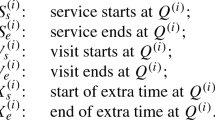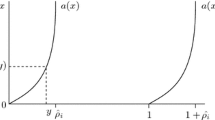Abstract
We consider a class of two-queue polling systems with exhaustive service, where the order in which the server visits the queues is governed by a discrete-time Markov chain. For this model, we derive an expression for the probability generating function of the joint queue length distribution at polling epochs. Based on these results, we obtain explicit expressions for the Laplace–Stieltjes transforms of the waiting-time distributions and the probability generating function of the joint queue length distribution at an arbitrary point in time. We also study the heavy-traffic behaviour of properly scaled versions of these distributions, which results in compact and closed-form expressions for the distribution functions themselves. The heavy-traffic behaviour turns out to be similar to that of cyclic polling models, provides insights into the main effects of the model parameters when the system is heavily loaded, and can be used to derive closed-form approximations for the waiting-time distribution or the queue length distribution.
Similar content being viewed by others
References
Abate, J., Whitt, W.: Numerical inversion of probability generating functions. Oper. Res. Lett. 12, 245–251 (1992)
Abate, J., Whitt, W.: Numerical inversion of Laplace transforms of probability distributions. ORSA J. Comput. 7, 36–43 (1995)
Athreya, K.B., Ney, P.E.: Branching Processes. Springer, New York (1972)
Boon, M.A.A., van der Mei, R.D., Winands, E.M.M.: Applications of polling systems. Surv. Oper. Res. Manag. Sci. 16, 67–82 (2011)
Boon, M.A.A., Winands, E.M.M.: Heavy-traffic analysis of \(k\)-limited polling systems. Probab. Eng. Inf. Sci. (2014, to appear)
Boon, M.A.A., Winands, E.M.M., Adan, I.J.B.F., van Wijk, A.C.C.: Closed-form waiting time approximations for polling systems. Perform. Eval. 68, 290–306 (2011)
Boxma, O.J., Groenendijk, W.P.: Two queues with alternating service and switching times. In: Boxma, O.J., Syski, R. (eds.) Queueing Theory and its Applications (Liber Amicorum for J. W. Cohen), pp. 261–282. North-Holland, Amsterdam (1988)
Boxma, O.J., Kella, O., Kosiński, K.M.: Queue lengths and workloads in polling systems. Oper. Res. Lett. 39, 401–405 (2011)
Boxma, O.J., Weststrate, J.: Waiting times in polling systems with Markovian server routing. In: Stiege, G., Lie, J.S. (eds.) Messung, Modellierung und Bewertung von Rechensystemen und Netzen, pp. 89–104. Springer, Berlin (1989)
Coffman, E.G., Puhalskii, A.A., Reiman, M.I.: Polling systems with zero switch-over times: a heavy-traffic principle. Ann. Appl. Probab. 5, 681–719 (1995)
Coffman, E.G., Puhalskii, A.A., Reiman, M.I.: Polling systems in heavy-traffic: a Bessel process limit. Math. Oper. Res. 23, 257–304 (1998)
den Iseger, P.: Numerical transform inversion using Gaussian quadrature. Probab. Eng. Inf. Sci. 20, 1–44 (2006)
Dorsman, J.L., Borst, S.C., Boxma, O.J., Vlasiou, M.: Markovian polling systems with an application to wireless random-access networks. Technical Report 2014–001, Eurandom Preprint Series, 2014. http://www.eurandom.tue.nl/reports/ (2014)
Dorsman, J.L., van der Mei, R.D., Winands, E.M.M.: A new method for deriving waiting-time approximations in polling systems with renewal arrivals. Stoch. Models 27, 318–332 (2011)
Grossglauser, M., Tse, D.: Mobility increases the capacity of ad hoc wireless networks. IEEE/ACM Trans. Netw. 10, 477–486 (2002)
Holma, H., Toskala, A.: HSDPA/HSUPA for UMTS: High Speed Radio Access for Mobile Communications. Wiley, Hoboken, NJ (2006)
Keilson, J., Servi, L.D.: The distributional form of Little’s law and the Fuhrmann–Cooper decomposition. Oper. Res. Lett. 9, 239–247 (1990)
Kleinrock, L., Levy, H.: The analysis of random polling systems. Oper. Res. 36, 716–732 (1988)
Konheim, A.G., Levy, H., Srinivasan, M.M.: Descendant set: an efficient approach for the analysis of polling systems. IEEE Trans. Commun. 42(234), 1245–1253 (1994)
Levy, H., Sidi, M.: Polling systems: application, modeling and optimization. IEEE Trans. Commun. 38, 1750–1760 (1990)
Olsen, T.L., van der Mei, R.D.: Polling systems with periodic server routeing in heavy traffic: distribution of the delay. J. Appl. Probab. 40, 305–326 (2003)
Reiman, M.I.: Some diffusion approximations with state space collapse. In: Modelling and Performance Evaluation Methodology (Paris. 1983), Lecture Notes in Control and Information Sciences, pp. 209–240. Springer, Berlin (1984)
Resing, J.A.C.: Polling systems and multitype branching processes. Queueing Syst. 13, 409–426 (1993)
Srinivasan, M.M.: Nondeterministic polling systems. Manag. Sci. 37, 667–681 (1991)
Takagi, H.: Analysis of Polling Systems. MIT Press, Cambridge, MA (1986)
Titchmarsh, E.C.: Theory of Functions. Oxford University Press, London (1939)
van der Mei, R.D.: Distribution of the delay in polling systems in heavy traffic. Perform. Eval. 38, 133–148 (1999)
van der Mei, R.D.: Towards a unifying theory on branching-type polling systems in heavy traffic. Queueing Syst. 57, 29–46 (2007)
van der Mei, R.D., Winands, E.M.M.: Heavy traffic analysis of polling models by mean value analysis. Perform. Eval. 65, 400–416 (2008)
van Wijk, A.C.C., Adan, I.J.B.F., Boxma, O.J., Wierman, A.: Fairness and efficiency for polling models with the \(\kappa \)-gated service discipline. Perform. Eval. 69, 274–288 (2012)
Vanghi, V., Damnjanovic, A., Vojcic, B.: The Cdma 2000 System for Mobile Communications: 3G Wireless Evolution. Prentice Hall PTR, Englewood Cliffs, NJ (2004)
Vishnevskii, V.M., Semenova, O.M.: Mathematical models to study the polling systems. Autom. Remote Control 67, 173–220 (2006)
Weststrate, J.A.: Analysis and Optimization of Polling Models. PhD thesis, Katholieke Universiteit Brabant (1992)
Weststrate, J.A., van der Mei, R.D.: Waiting times in a two-queue model with exhaustive and Bernoulli service. Zeitschrift für Oper. Res. 40, 289–303 (1994)
Acknowledgments
The authors wish to thank Marko Boon, Sem Borst and Maria Vlasiou for valuable comments on earlier drafts of the present paper. Funded in the framework of the STAR-project “Multilayered queueing systems” by the Netherlands Organization for Scientific Research (NWO). The research of Onno J. Boxma is performed in the IAP Bestcom project, funded by the Belgian government.
Author information
Authors and Affiliations
Corresponding author
Appendices
Appendix 1: Proof of Lemma 3.1
Proof
We first focus on the value of \(\left| 1-f_1^{(\infty )}(z_2)\right| = \lim _{j \rightarrow \infty } \left| 1-f_1^{(j)}(z_2)\right| \). For arbitrary \(j>0\), we have for any \(z_2\) in the unit circle that
where the inequality constitutes the triangle inequality. Note that \(\left| 1-e^{-x}\right| \le \left| x\right| \) for any \(x \in \{z\in \mathbb {C}: \mathfrak {R}(z) > 0\}\), so that
Iteration of (32) leads to
By (1) we have that \(\mathbb {E}[P_i] = \mathbb {E}[B_i](1-\rho _i)^{-1}\), so that
The inequality follows since the queues are assumed to be stable, i.e., \( 0 \le \rho < 1\). Therefore, \(\rho _1 = \rho -\rho _2 < 1-\rho _2\), and similarly \(\rho _2 < 1-\rho _1\). A combination of (32) and (34) now leads to
Since \(\lim _{j \rightarrow \infty } \left| 1-f_1^{(j)}(z_2)\right| = 0\), we must have that \(f_1^{(\infty )}(z_2) = \lim _{j \rightarrow \infty } f_1^{(j)}(z_2) = 1\).
By similar arguments, it can be shown that \(f_2^{(\infty )}(z_1)=1\) for any \(z_1\) in the unit circle. Finally, it is evident that \(\widetilde{K}_{1,2}(1) = \widetilde{K}_{2,1}(1) = \widetilde{F}_1(1,1) = \widetilde{F}_2(1,1) = 1\). The lemma now follows. \(\square \)
Appendix 2: Proof of Lemma 3.2
Proof
We initially focus on the product \(\prod _{j=0}^\infty a_1(f_1^{(j)}(z_2))\). By the theory of infinite products (see e.g., [26, Chapter 1]), we have that \(\prod _{j=0}^\infty a_1(f_1^{(j)}(z_2))\) converges iff \(\sum _{j=0}^\infty (1-a_1(f_1^{(j)}(z_2)))\) converges. To establish the latter, it is enough to prove that \(\sum _{j=0}^\infty \left| 1-a_1(f_1^{(j)}(z_2))\right| \) converges. We observe that
where
Using the triangle inequality and similar arguments as those in the proof of Lemma 3.1, we note that for \(1 \le i,k \le 2\) and \(j>0\),
Moreover, it is trivially seen that \(\left| A_{i,k}(z_2)\right| \le 1\) for \(1 \le i,k \le 2\) and any \(z_2\) in the unit circle. Furthermore, since \(\left| \widetilde{M}_{i,k}(\widetilde{K}_{1,2}(z_2), z_2)\right| \le 1\), we have that \(|D(z_2)| \ge (1-r_{1,1})(1-r_{2,2})\). Therefore, a combination of (33) and (35) with the triangle inequality leads to
This result obviously shows, in combination with (34), that \(\sum _{j=0}^\infty \left| 1-a_1(f_1^{(j)}(z_2))\right| \) is bounded from above by a converging geometric sum. As such, \(\sum _{j=0}^\infty \left| 1-a_1(f_1^{(j)}(z_2))\right| \) converges, so that \(\prod _{j=0}^\infty a_1(f_1^{(j)}(z_2))\) converges. The convergence of the product \(\prod _{j=0}^\infty a_2(f_2^{(j)}(z_1))\) can be established similarly. \(\square \)
Rights and permissions
About this article
Cite this article
Dorsman, Jp.L., Boxma, O.J. & van der Mei, R.D. On two-queue Markovian polling systems with exhaustive service. Queueing Syst 78, 287–311 (2014). https://doi.org/10.1007/s11134-014-9413-y
Received:
Revised:
Published:
Issue Date:
DOI: https://doi.org/10.1007/s11134-014-9413-y
Keywords
- Markovian routing
- Waiting-time distribution
- Queue length distribution
- Descendant set approach
- Heavy-traffic behaviour




